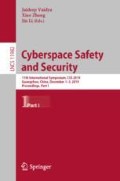Abstract
With the continuous changes in social needs, Smart City that become a new engine for traditional urban economic transformation, industrial upgrading and urban management. Around the popularity of Smart City, the combination of cloud computing, wireless mobile networks and IoT technology undoubtedly has become a perfect match. However, when the information obtained by the IoT devices are transmitted through the wireless network, people in the city are faced with a lot of personal information leaked without knowing it. This problem, which not only requires the introduction and improvement of relevant laws, but also brings new challenges to the cryptographic technology. This paper proposes an automatically scalable invisible membrane image encryption solution for image privacy issues for the smart city through IoT-based sensors environment. The scheme utilizes the integer vector homomorphic encryption algorithm (VHE) to flexibly generate invisible membrane based on the size of the privacy image to protect private information.
The first author is a master candidate.
Access this chapter
Tax calculation will be finalised at checkout
Purchases are for personal use only
Notes
- 1.
OpenCV data set. https://docs.opencv.org/3.0-beta/modules/datasets/doc/datasets.html.
- 2.
PSNR can evaluate the quality of the decoded image.
- 3.
Information entropy is the most important measure of randomness in information theory and the maximum entropy of an gray image should be as 8 when all of the pixels are equally distributed, which shows that the information is random.
- 4.
NPCR and UACI are two most common quantities that used to evaluate the strength of image encryption algorithms with respect to differential attacks.
References
NIISAY asset management. Seventy percent of the world population in 2050 will be urban residents (2018)
Gaur, A., Scotney, B., Parr, G., et al.: Smart city architecture and its applications based on IoT. Procedia Comput. Sci. 52, 1089–1094 (2015)
Yang, B., Zhang, C., Yong, T., et al.: Vehicle detection and recognition for intelligent traffic surveillance system. Multimed. Tools Appl. 76, 5817–5832 (2015)
Pramkeaw, P., Ngamrungsiri, P., Ketcham, M.: CCTV face detection criminals and tracking system using data analysis algorithm. In: Theeramunkong, T., et al. (eds.) iSAI-NLP 2017. AISC, vol. 807, pp. 105–110. Springer, Cham (2019). https://doi.org/10.1007/978-3-319-94703-7_10
Sachdeva, A., Mahajan, P.: A study of encryption algorithms AES, DES and RSA for security. Global J. Comput. Sci. Technol. 13, 15–22 (2013)
Manimurugan, S., John Justin, M.: A survey on various encryption techniques. Int. J. Soft Comput. Eng. 2, 429–432 (2013)
Redmon, J., et al.: You only look once: unified, real-time object detection. In: Proceedings of the IEEE Conference on Computer Vision and Pattern Recognition, pp. 779–788 (2016)
Pytorch. https://pytorch.org/
Zhou, H., Wornell, G.: Efficient homomorphic encryption on integer vectors and its applications. In: Proceedings of 2014 Information Theory and Applications Workshop (ITA), pp. 22–31 (2014)
Huynh-Thu, Q., Ghanbari, M.: Scope of validity of PSNR in image/video quality assessment. Electron. Lett. 44, 800–801 (2008)
Alawida, M., Samsudin, A., Teh, J.S.: A new hybrid digital chaotic system with applications in image encryption. Signal Process. 160, 44–58 (2019)
Xu, L., Li, Z., Li, J., et al.: A novel bit-level image encryption algorithm based on chaotic maps. Opt. Lasers Eng. 78, 17–25 (2016)
Docker. https://www.docker.com/
Author information
Authors and Affiliations
Corresponding author
Editor information
Editors and Affiliations
Copyright information
© 2019 Springer Nature Switzerland AG
About this paper
Cite this paper
Lv, S., Liu, Y., Sun, J. (2019). IMES: An Automatically Scalable Invisible Membrane Image Encryption for Privacy Protection on IoT Sensors. In: Vaidya, J., Zhang, X., Li, J. (eds) Cyberspace Safety and Security. CSS 2019. Lecture Notes in Computer Science(), vol 11982. Springer, Cham. https://doi.org/10.1007/978-3-030-37337-5_21
Download citation
DOI: https://doi.org/10.1007/978-3-030-37337-5_21
Published:
Publisher Name: Springer, Cham
Print ISBN: 978-3-030-37336-8
Online ISBN: 978-3-030-37337-5
eBook Packages: Computer ScienceComputer Science (R0)

